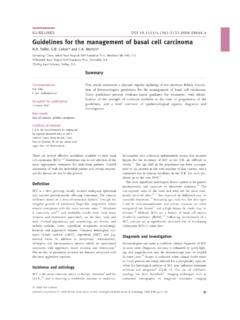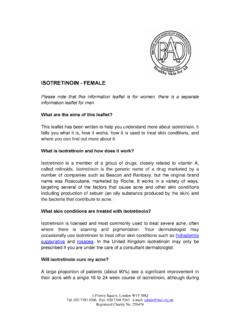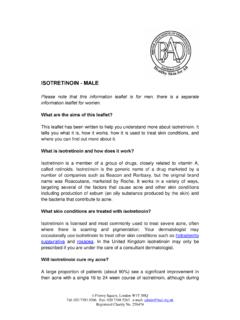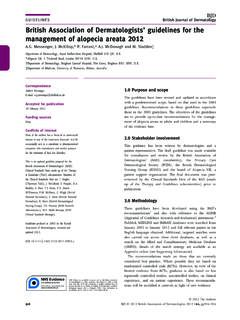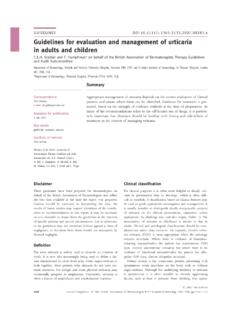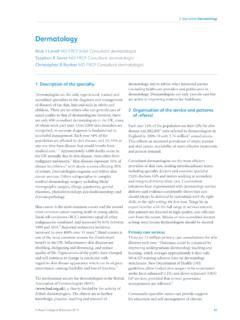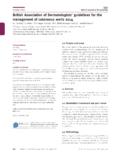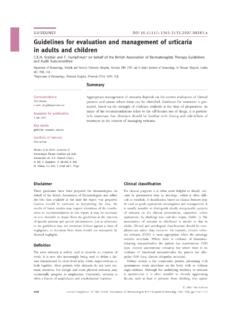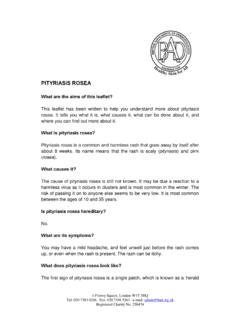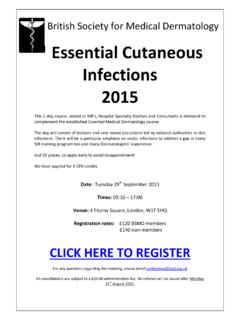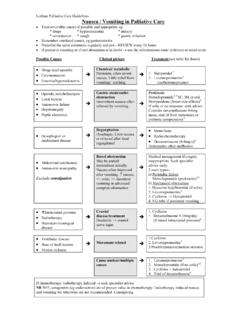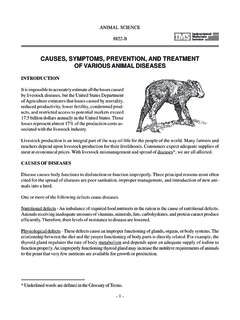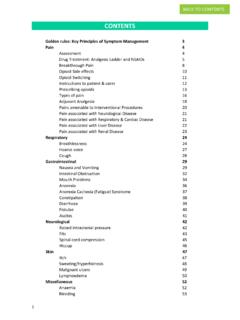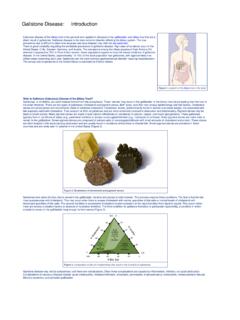Transcription of URTICARIA AND ANGIOEDEMA - British Association of ...
1 4 Fitzroy Square, London W1T 5HQ Tel: 020 7383 0266 Fax: 020 7388 5263 e-mail: Registered Charity No. 258474 URTICARIA AND ANGIOEDEMA What are the aims of this leaflet? This leaflet has been written to help you understand more about URTICARIA and ANGIOEDEMA . It tells you what they are, what causes them, what you can do about them, and where you can find out more about them. What is URTICARIA and ANGIOEDEMA ? URTICARIA is common, and affects about 20% of people at some point in their lives. It is also known as hives or nettle rash. The short-lived swellings of URTICARIA are known as weals (see below) and typically any individual spot will clear within 24 hours although the overall rash may last for longer.
2 ANGIOEDEMA is a form of URTICARIA in which there is deeper swelling in the skin, and the swelling may take longer than 24 hours to clear. An affected individual may have URTICARIA alone, ANGIOEDEMA alone, or both together. Both are caused by the release of histamine from cells in the skin called mast cells. When ANGIOEDEMA occurs in Association with URTICARIA , the two conditions can be considered part of the same process. When ANGIOEDEMA occurs on its own, different causes need to be considered. There are different types of URTICARIA of which the most common form is called ordinary or idiopathic URTICARIA .
3 In this type no cause is usually identified and often patients have hives and ANGIOEDEMA occurring together. Ordinary URTICARIA with or without ANGIOEDEMA is usually divided into acute and chronic forms. In acute URTICARIA / ANGIOEDEMA , the episode lasts from a few days up to six weeks. Chronic URTICARIA , by definition, lasts for more than six weeks. Ongoing ordinary URTICARIA should be differentiated from an isolated individual episode of acute URTICARIA which occurs for example with ingestion of or contact with an allergen. 4 Fitzroy Square, London W1T 5HQ Tel: 020 7383 0266 Fax: 020 7388 5263 e-mail: Registered Charity No.
4 258474 Other less common types of URTICARIA are described later in this leaflet. Also included is urticarial vasculitis (in which inflammation of the blood vessels causes an urticarial-like rash, and is therefore different from normal URTICARIA ). What causes URTICARIA and ANGIOEDEMA ? In the common ordinary form of URTICARIA and ANGIOEDEMA , it is unusual for an external cause to be identified. Intercurrent infections such as a cold, influenza or a sore throat may act as a trigger. Almost any medicine can cause acute URTICARIA , but painkillers (especially aspirin and medicines like ibuprofen), antibiotics (especially penicillins) and vaccinations are most likely to be responsible.
5 ANGIOEDEMA , in particular, can be caused by a type of drug (ACE inhibitors) used to treat high blood pressure. In some patients with ordinary chronic URTICARIA , the release of histamine from skin mast cells is triggered by factors circulating in the blood, such as antibodies directed against their own mast cells - a process known as autoimmunity. Tests for this are not routinely available, and generally do not alter the treatments used. What are the symptoms of URTICARIA and ANGIOEDEMA ? The main symptom of URTICARIA is itch but ANGIOEDEMA is not usually itchy.
6 Although URTICARIA can be distressing, because of the itching and its appearance, it has no direct effect on general health. Rarely, the swelling of ANGIOEDEMA may affect the tongue or throat, causing difficulty with breathing or swallowing. This can be alarming but is rarely life-threatening. Are URTICARIA and ANGIOEDEMA hereditary? The ordinary common type of URTICARIA and ANGIOEDEMA is not hereditary. What do ordinary URTICARIA and ANGIOEDEMA look like? The weals of URTICARIA may be flesh-coloured, pink or red. They can be of different shapes and sizes, but usually look like nettle stings.
7 An important feature of URTICARIA is that although the rash may persist for weeks, individual lesions usually disappear within a day, and often last only a matter of hours. However, they sometimes leave bruising especially in children. New weals may then appear in other areas. In ordinary URTICARIA , the weals can occur anywhere on the body, at any time. 4 Fitzroy Square, London W1T 5HQ Tel: 020 7383 0266 Fax: 020 7388 5263 e-mail: Registered Charity No. 258474 The deeper swellings of ANGIOEDEMA occur most frequently on the eyelids, lips and sometimes in the mouth, but they may occur anywhere.
8 They are not usually itchy, and tend to settle within a few days. If the hands and feet are affected, they may feel tight and painful. How will ordinary URTICARIA be diagnosed? Usually its appearance, or a description of it, will be enough for your doctor to make the diagnosis. In the vast majority of people no cause can be found, though your doctor will ask you questions to try to identify one. There is no special test that can reliably identify the cause of ordinary (idiopathic) URTICARIA , but some tests may be done if your answers suggest an underlying cause, which may be suspected from a detailed history.
9 Occasionally, if a trigger is suspected, a specific blood test, to detect antibodies in the bloodstream, or a skin prick test may be performed by a specialist in skin or allergic disease. In chronic URTICARIA , no specific trigger is usually identified so routine allergy tests are not necessary. In a small percentage of people, foods, colouring agents and preservatives appear to worsen URTICARIA , and it might be helpful to identify these by keeping a food diary. These substances can be left out of the diet to see if the condition improves, and later reintroduced to confirm whether they are the cause of the URTICARIA .
10 However, as URTICARIA is such a fluctuating disease, this is not always accurate and will not always show you definitely what is causing the problem. Can ordinary URTICARIA and ANGIOEDEMA be cured? The treatments outlined below suppress the condition rather than cure it. In about half of the people affected by chronic ordinary URTICARIA , the rash lasts for 6-12 months, and then gradually disappears. It can however last considerably longer. In any one individual the course of URTICARIA is unpredictable. What is the treatment for ordinary URTICARIA ?
